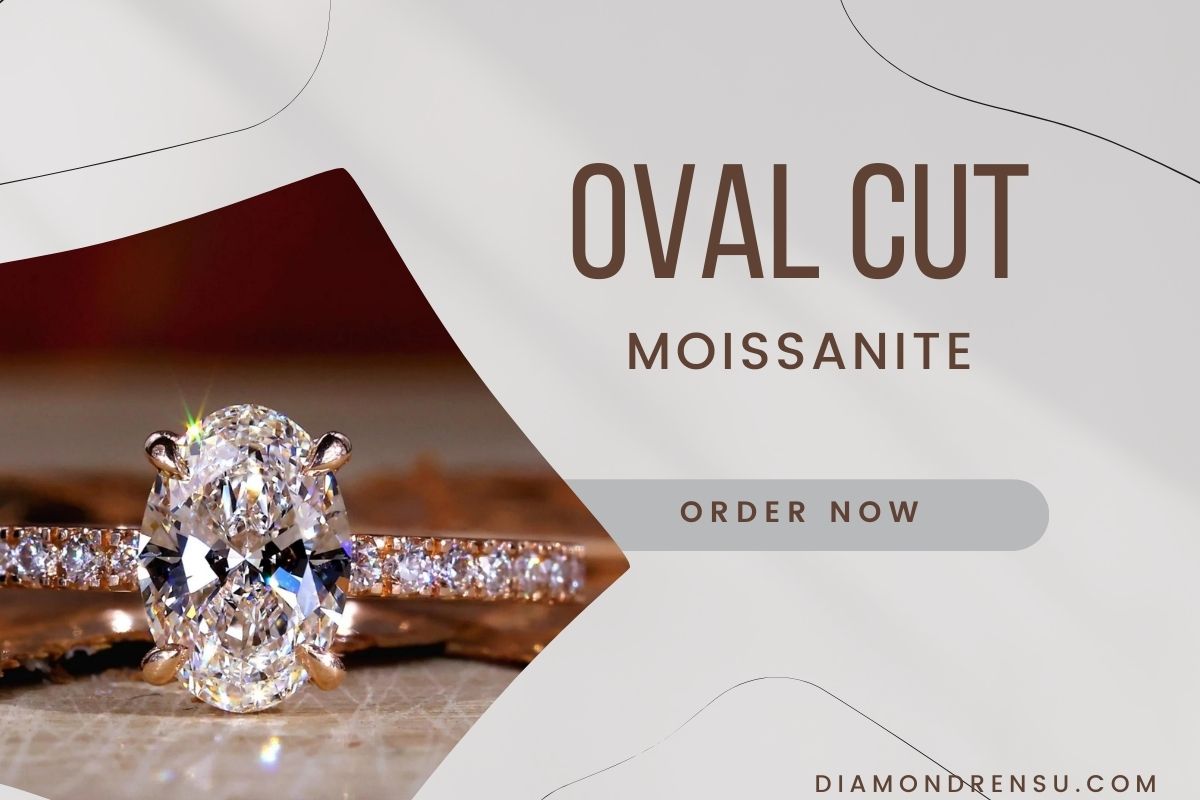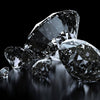
Oval Diamond Size Chart on Hand: Visual Guide to Carat Scale
When selecting an oval diamond, understanding how it presents on your hand is crucial. Diamond size perception varies depending on the shape and carat weight, and oval diamonds carry their unique appeal and considerations. Oval diamonds are elongated and can appear larger than round diamonds of the same carat weight, offering a flattering effect on the hand. An oval diamond size chart becomes a handy tool, providing a visual reference that allows you to gauge the appearance of different sizes on your finger.
Table Of Contents
- Understanding Diamond Basics
- Diamond Sizes and Shapes
- Oval Diamond Size Chart and Proportions
- Engagement Ring Considerations
- Optical Performance and Quality
- Practical Buying Guide
- Metal Choices for Oval Diamond Rings
- Caring for Your Oval Diamond
- The Legacy of Oval Diamonds
- Frequently Asked Questions
Your choice will also be influenced by the diamond's length-to-width ratio, which affects its overall shape and how it will sit on your hand. While some may prefer a more elongated oval for its graceful appearance, others may opt for a more rounded shape for a classic look. Proportional balance is key, and it’s important to view actual size representations or, if possible, try on different oval diamond sizes to understand how they might complement your hand's shape and size.
Remember, the way a diamond's size is perceived on the hand can also be affected by the ring's setting and style. For instance, a slender band can make the diamond appear larger, whereas a wide band might make it seem smaller. The visual spread of an oval diamond is an essential element of its allure, making it imperative to consider these factors when consulting a size chart or viewing diamonds in person.
Understanding Diamond Basics
When selecting a diamond, it’s crucial for you to understand the core elements that determine its value and appeal. These are traditionally summed up as the 4 Cs: Carat, Color, Clarity, and Cut. Understanding these will help guide your choice, especially when considering an oval cut diamond, which has its own unique characteristics.
The 4 Cs: Carat, Color, Clarity, and Cut
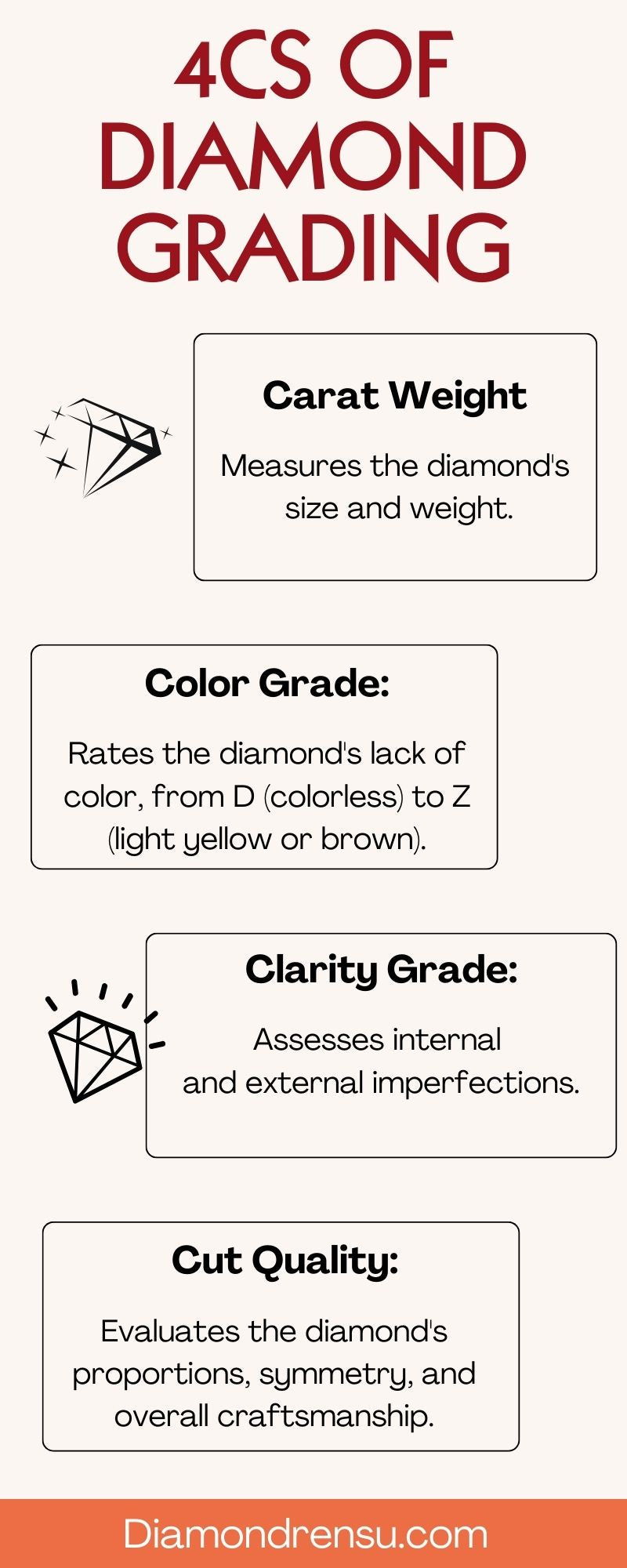
-
Carat Weight: Carat refers to the weight of the diamond. One carat is equivalent to 200 milligrams. The size and visual impact of a diamond on the hand are significantly influenced by its carat weight, with higher carat weights typically resulting in a more prominent appearance.
-
Color: The GIA color grading scale for diamonds ranges from D (colorless) to Z (light yellow or brown). Most desirable are the colorless diamonds, as they allow the most refraction of light, but slight coloration doesn't necessarily detract from a diamond's beauty and may make it more affordable.
-
Clarity: Clarity is graded based on the presence of inclusions and blemishes. The GIA clarity scale includes 11 grades, from Flawless to I3. A diamond's clarity can affect its sparkle, however, many inclusions are too small to be visible to the naked eye.
-
Diamond Cut: The cut of a diamond refers to how well it has been shaped and faceted. A well-cut diamond will reflect light beautifully, leading to that sought-after sparkle. Cut grades range from Excellent to Poor.
Oval Cut Diamond Characteristics
-
Shape Ratio: For an oval cut diamond, the ratio between the length and width is important and should ideally be between 1.3:1 and 1.5:1 to create a balanced appearance on the hand.
-
Bowtie Effect: Some oval cut diamonds exhibit a bowtie-shaped shadow across their central facet. While it's a characteristic of the cut, the extent of the visibility varies and can impact the diamond's overall beauty.
-
Certification: Always ensure your oval diamond comes with a certification from a reputable lab like the GIA, verifying its 4 Cs. This provides an assurance of the diamond’s quality and authenticity.
When considering an oval cut diamond for your ring, remember that while carat weight gives an indication of size, the specific dimensions and ratio will determine how the diamond actually looks and fits on the hand.
Diamond Sizes and Shapes

Understanding diamond sizes and shapes will help you make an informed choice that flatters your hand. The carat weight and dimensions of the diamond play crucial roles in its appearance.
Comparison of Oval and Round Diamonds
When comparing oval diamonds to round diamonds, it's essential to consider both aesthetic and practical considerations. Oval diamonds often appear larger than round diamonds of the same carat due to their elongated shape, providing an illusion of greater size for your carat weight. Despite their difference in appearance, both shapes provide excellent brilliance and fire, though the round diamond is typically known for its unmatched sparkle.
Round diamonds have a classic look and are the most popular diamond shape on the market. They typically exhibit more brilliance and fire because of their symmetrical shape and the refinements in their cut over many years. However, oval diamonds can give fingers a more elongated look, which is a desirable trait for many.
Other Popular Diamond Shapes
- Princess: Known for its sharp angles and contemporary look, princess cut diamonds are second in popularity, offering a modern aesthetic.
- Cushion: With softened corners and large facets, cushion cut diamonds blend the antique with the modern and give off a romantic glow.
- Emerald: The emerald cut is all about elegance and clarity with its long, step-like facets and transparent look.
- Asscher: This is similar to an emerald cut but is square, offering a unique vintage appeal with its deep cut and high crown.
- Marquise: The football-shaped marquise diamonds provide the illusion of size and can also make the finger appear longer and slimmer.
- Radiant: Combining the brilliance of a round diamond with the shape of an emerald cut, radiant diamonds are known for their lively sparkle.
- Heart: As a symbol of love, heart-shaped diamonds are perfect declarations of romance, though less common in engagement rings.
- Pear: Also known as teardrop diamonds, pear-shaped diamonds are a combination of round and marquise shapes, with a tapered point on one end.
Each diamond shape carries its own set of characteristics and visual impact, with size and shape influencing the stone's overall presence on the hand. Keep in mind that the size and proportions of the diamond should complement the size and shape of your hand and fingers.
Oval Diamond Size Chart and Proportions

Understanding the dimensions of oval diamonds is crucial for selecting a stone that's perfect for you. The size chart and proportions are determined primarily by the length-to-width ratio and carat weight, affecting the diamond's physical appearance on your hand.
| Diamond Size (MM) | Carat Weight |
|---|---|
| 5.25 x 3.71 mm | 0.30 ct |
| 5.72 x 4.22 mm | 0.40 ct |
| 6.29 x 4.54 mm | 0.50 ct |
| 6.56 x 4.78 mm | 0.60 ct |
| 7.05 x 4.86 mm | 0.70 ct |
| 7.84 x 5.00 mm | 0.80 ct |
| 7.45 x 5.49 mm | 0.90 ct |
| 7.94 x 5.77 mm | 1.0 ct |
| 8.79 x 5.50 mm | 1.10 ct |
| 8.63 x 5.94 mm | 1.20 ct |
| 8.88 x 6.05 mm | 1.4 ct |
| 8.95 x 6.68 mm | 1.6 ct |
| 9.12 x 6.72 mm | 1.8 ct |
| 9.61 x 7.10 mm | 2.0 ct |
| 10.36 x 7.74 mm | 2.5 ct |
| 11.05 x 8.23 mm | 3.0 ct |
| 12.91 x 8.29 mm | 3.5 ct |
Length-to-Width Ratio Explained
The length-to-width ratio of an oval diamond is a key indicator of its shape and how elongated it appears. This ratio is calculated by dividing the length by the width of the diamond. A higher ratio signifies a more elongated oval; the typical range is from 1.30 to 1.50, which is considered the classic oval shape. Knowing this ratio helps you anticipate the diamond's outline before viewing it in person.
- Ideal Ratio Range:
- Classic Look: 1.30 - 1.50
- More Elongated: > 1.50
- Shorter, Wider Look: < 1.30
Selecting a Flattering Oval Diamond Size
When choosing an oval diamond, consider the physical size, which relates to the carat weight but isn't the sole indicator of the stone's dimensions. Carat weight reflects a diamond's mass, but two diamonds of equal weight can appear quite different in size based on their cut proportions.
- Diamond Carat Size Chart:
- 0.25 ct: approximately 4.1mm x 3mm
- 0.50 ct: approximately 5.1mm x 3.9mm
- 1.00 ct: approximately 7.0mm x 5mm
- 2.00 ct: approximately 8.5mm x 6.5mm
It's important to consider the size of the diamond in relation to your finger size and the setting style. A diamond's presence is enhanced by the setting, with certain styles making the diamond appear larger. Your personal preference for the diamond's shape and how it complements your hand will guide your selection for a flattering look.
Engagement Ring Considerations
When selecting an engagement ring, the choice of an oval diamond and the setting style are crucial factors that affect the ring's appearance and comfort. Your decision should reflect your personal style while enhancing the diamond's beauty.
Oval Diamond Engagement Rings
Oval diamonds are renowned for their elongated shape, which not only creates the illusion of greater size but also brings a unique elegance to engagement rings. One of the first things to consider is the length-to-width ratio, which affects the diamond’s overall shape. A classic oval diamond typically has a ratio between 1.30 and 1.50. Here, precision matters; a well-proportioned oval diamond will make your engagement ring stand out.
When it comes to size, consider how the diamond will look on your hand. An oval diamond size chart on hand can provide helpful visual guidance.
Choosing the Right Setting
The right ring setting not only secures the diamond but also complements it. A solitaire setting is timeless and puts the focus on the oval diamond itself, offering a minimalistic yet powerful statement. If you prefer a more secure and sleek design, the bezel setting surrounds the diamond and can make it appear larger.
For added sparkle, a side-stone setting incorporates smaller diamonds along the band, enhancing the oval diamond's brilliance. Alternatively, a halo setting surrounds the central stone with a circle of smaller diamonds, which creates a spectacular effect and gives the appearance of a larger center diamond.
Each setting style has its own characteristics and contributes to the overall aesthetic of your engagement ring. Whether you gravitate towards the simplicity of a solitaire or the added flair of a halo, choose a setting that resonates with your personal style and complements the oval diamond's elegance.
Optical Performance and Quality
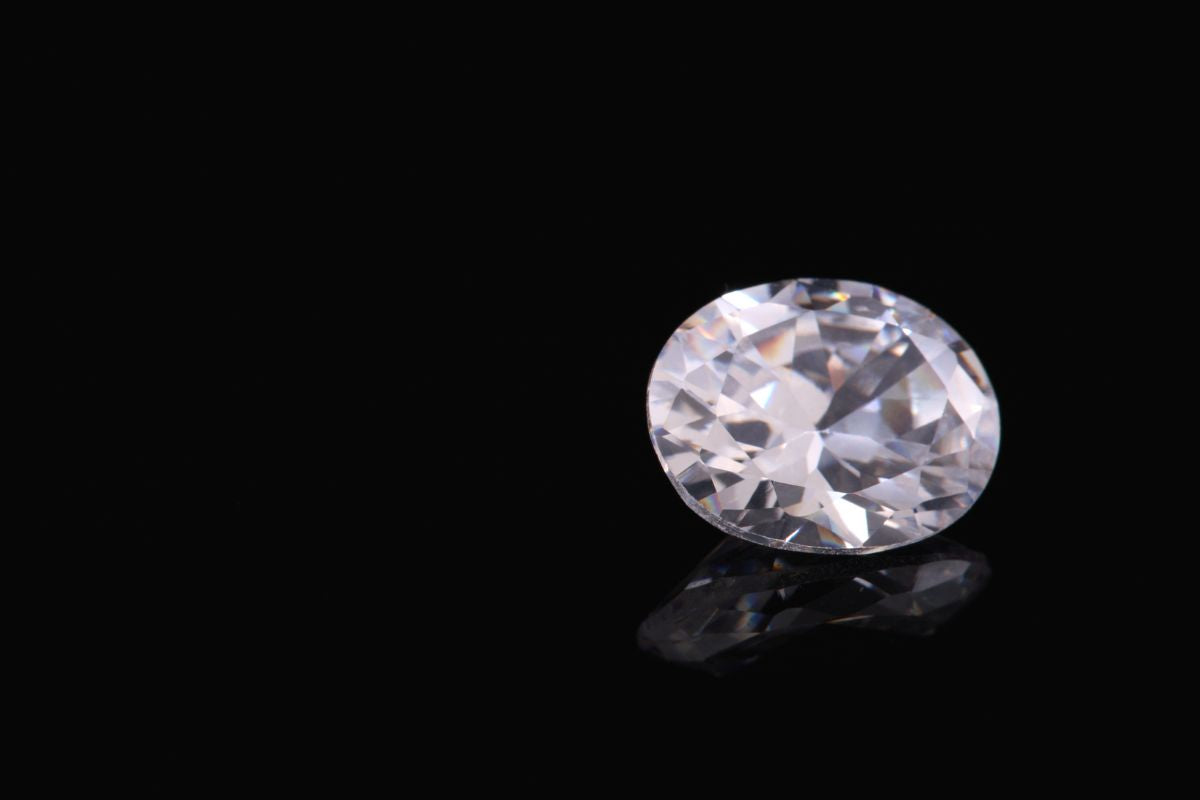
When you select an oval diamond, its optical performance—how it interacts with light to create visual effects like brilliance and fire—is of paramount importance. The quality of the cut is crucial in determining just how much sparkle and beauty your diamond will display.
Impact of Cut on Brilliance and Fire
The cut of your oval diamond is pivotal in how the stone captures light and reflects it back. An excellent cut oval diamond has been crafted to ensure maximum brilliance, which refers to the light reflected from the inside of the diamond, and fire, the dispersion of light into the colors of the spectrum. To achieve an eye-catching sparkle, precise artistry is required; each facet must be cut at the correct angle to optimize the diamond's interaction with light.
- Brilliance: Brightness created by a combination of all the white light reflections from the surface and interior of a diamond.
- Fire: The flashes of color you can see in a diamond as it moves under a light source.
Identifying Inclusions and Blemishes
Understanding inclusions and blemishes is key in evaluating the clarity of an oval diamond. Inclusions are internal imperfections such as small crystals, clouds, or feathers, whereas blemishes include surface flaws like scratches or nicks. While inclusions can impact a diamond's clarity and sparkle, a diamond can be considered "eye clean" if these imperfections are invisible to the naked eye, which is often the case with diamonds that boast a high cut quality.
- Inclusions: May affect the passage of light through the diamond, diminishing sparkle and brilliance.
- Blemishes: Generally have less impact on the optical qualities, unless severe.
When it comes to an oval diamond size chart on hand, the cut grading becomes even more vital; a well-cut diamond will maintain its optical efficiency relative to its size on your hand, ensuring that it displays its best possible appearance.
Practical Buying Guide

When buying an oval diamond, your main considerations should revolve around your budget and the stone's value and quality. Understanding these factors ensures you make a well-informed and confident decision.
Budgeting for an Oval Diamond
You'll need to set a budget that reflects both your financial comfort level and the market's price range for oval diamonds. Prices for these gems can vary widely based on carat size, color grade, and clarity grade. Start by researching the average cost per carat for diamonds with the specific attributes you're interested in. For instance:
- 0.50 Carat: $1,000 - $2,500
- 1.00 Carat: $3,000 - $8,000
- 1.50 Carat: $6,000 - $12,000
Remember, prices escalate with carat size due to the rarity of larger stones.
Assessing Value and Quality
To assess a diamond's value and quality, prioritize clarity grades and color grades alongside size. An ideal oval diamond balances a high color grade (D through H) with a clarity grade that doesn't significantly impact the appearance (VS1 and higher is typically a good standard). Consider the following characteristics:
- Color Grade: A scale from D (colorless) to Z (light color). Aim for a grade that appears white in relation to its setting.
- Clarity Grade: Classified from Flawless to Included, seek a diamond that has no visible inclusions or blemishes to the naked eye.
Use this knowledge to find the best diamond within your budget, ensuring you get both beauty and value. Keep in mind that an oval diamond's elongated shape can also give the illusion of a larger size, which might allow you to opt for a smaller, less expensive carat while still achieving a striking presence on the hand.
Metal Choices for Oval Diamond Rings
When you select a metal for your oval diamond ring, you consider how the sheen, durability, and color complement the unique size and shape of the gemstone on your hand.
Metal Types and Their Impact on Appearance
-
White Gold: A popular choice, white gold provides a sleek, modern finish that amplifies the brilliance of oval diamonds. It's an alloy of gold mixed with white metals like nickel or palladium, often coated with rhodium for extra shine and durability.
-
Platinum: Distinguished by its superior strength and natural white luster, platinum is a prestigious choice that holds diamonds securely. Its density makes it more resistant to wear and it enhances the sparkle of the stone without any additional plating.
-
Rose Gold: This romantic metal, with its warm pink hue, creates a vintage appeal. Rose gold is an alloy of gold and copper, and it brings out the soft tones in the diamond, giving a flattering glow to most skin types.
-
Yellow Gold: Classic and timeless, yellow gold adds a warm contrast that can accentuate the size and cut of an oval diamond. It's the purest color of all gold types, and its traditional aspect makes it eternally stylish.
Each type of metal impacts not only the ring's overall aesthetic but also factors such as hypoallergenic properties, maintenance level, and cost-effectiveness. When you view an oval diamond size chart on hand, imagine how each metal hue might complement your skin tone and personal style.
Caring for Your Oval Diamond

When maintaining the brilliance of your oval diamond, understanding its anatomy is key. A diamond's table, the flat top surface, is its largest facet and plays a significant role in its shine. To keep this surface gleaming, use a soft cloth for regular cleaning. The table percentage, which is the table width relative to the diamond's diameter, should be considered when cleaning as it can affect the diamond's interaction with light.
The depth of your diamond, or the height from table to culet, should also be kept in pristine condition. The depth percentage, the depth relative to the overall size of the stone, is crucial for optimal light reflection. Handle your diamond with care to avoid chipping the girdle, especially during cleaning.
Here are some care tips:
- Regular Cleaning: Gently clean your diamond with a mild soap and a soft-bristled brush. Pat dry with a lint-free cloth.
- Avoid Harsh Chemicals: Keep your diamond away from harsh chemicals that can dull its sparkle or damage the girdle.
- Annual Check-ups: Have your diamond professionally checked once a year to inspect the setting and ensure it's secure.
- Safe Storage: Store your diamond separately from other jewelry to prevent scratches. A fabric-lined jewelry box with dividers is ideal.
Remember, your oval diamond's unique shape requires attentive care to maintain its beauty and structural integrity. With these tips, your precious gem will continue to captivate for years to come.
The Legacy of Oval Diamonds
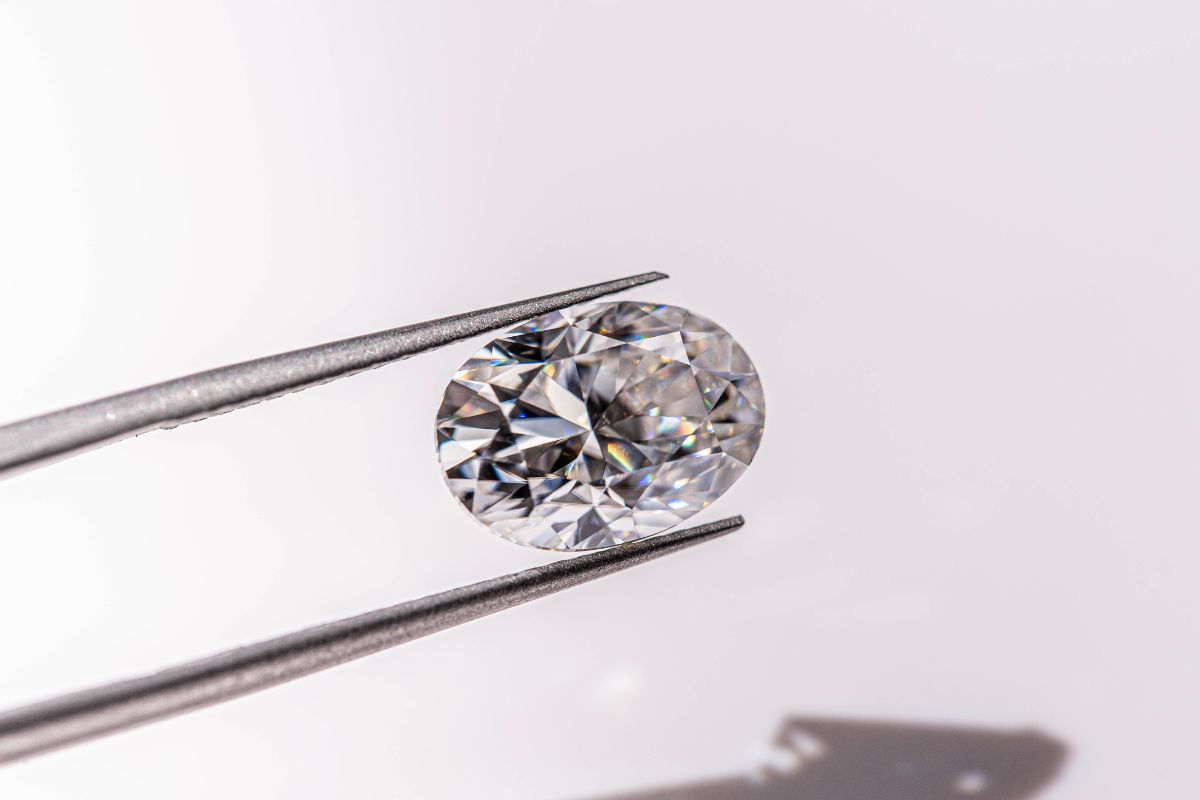
Oval diamonds are renowned for their elegance and have a rich history that intertwines with the expertise of legendary diamond cutters. As you explore their background, you'll see how they've been shaped both literally and figuratively by innovations in gemology.
Historical Highlights
The history of oval diamonds is a tapestry of opulence and refinement. These fancy-shaped diamonds have been favored for centuries, their elongated shape offering a unique appeal compared to traditional round cuts. Notably, the Gemological Institute of America (GIA) plays a critical role in classifying these gems, ensuring that each exhibits the brilliance and quality one would expect from such esteemed natural diamonds. Whether set in a royal tiara or gracing the finger in a modern engagement ring, oval diamonds carry with them a legacy of grandeur from their historic past.
Influence of Famous Diamond Cutters
One can't discuss the legacy of oval diamonds without mentioning the artisanal influence of renowned diamond cutters like Lazare Kaplan. Kaplan's contribution in the early 20th century revolutionized the world of diamond cutting, bringing the oval diamond to the forefront of desirability. His proficiency in shaping these precious stones is a testament to the artistry involved in creating diamonds that balance the inherent brilliance and fire of their natural form. Today, whether one chooses a timeless piece featuring natural diamonds or opts for the innovation of lab-created diamonds, the influence of masters like Kaplan is evident in every facet.
Frequently Asked Questions
When considering an oval diamond for any piece of jewelry, it's important to understand how size relates to visual appearance on your hand and what aspects contribute to an oval diamond's appeal.
How does carat weight relate to oval diamond dimensions on the finger?
Carat weight specifically refers to the diamond's mass, not its size. However, higher carat weights often result in a larger appearance on the hand, with oval diamonds typically displaying a larger surface area than round diamonds of the same carat.
What are ideal proportions for an oval diamond to maximize its appearance?
Ideal proportions for an oval diamond should include a length-to-width ratio between 1.3 and 1.5. This range typically maximizes the diamond's elegant shape without it appearing too long or too round on the hand.
How does a 2 carat oval diamond compare in size to other diamond shapes on the hand?
A 2 carat oval diamond generally appears larger on the hand than a 2 carat round diamond due to its elongated shape and larger surface area. Compared to other shapes, an oval can provide the illusion of greater size and lengthen the look of the finger.
What factors should be considered when choosing an oval diamond to ensure it complements finger size?
When choosing an oval diamond, consider finger length and width; a long and slender oval diamond can accentuate short fingers, while a wider oval may flatter wider fingers. The shape's curvature can both complement and contrast hand proportions.
Is there a noticeable size difference between a 1 carat and a 1.5 carat oval diamond when worn?
There is a noticeable difference between a 1 carat and a 1.5 carat oval diamond on the hand, given that the surface area and dimensions generally increase with carat weight, visibly impacting the diamond's presence on the finger.
What characteristics define the perfect oval diamond for an engagement ring?
The perfect oval diamond for an engagement ring combines ideal cut, symmetry, and length-to-width ratio, resulting in a brilliant stone that flatters the finger and exhibits the desired aesthetic. Clarity and color also play significant roles in its overall beauty.
Checkout some of our top collections:
